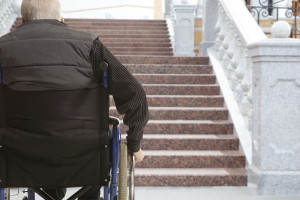According to the Americans with Disabilities Act website, Title III of the Act requires public adaptations to provide goods and services to people with disabilities on an equal basis with everyone else. As part of these requirements, any business open to the public must adhere to the building compliance requirements of the ADA. If you are a person with a disability here are just some of the things to look for to ensure that you can patronize businesses of your choosing.
It is a requirement that businesses have accessible approaches and entrances. This accessibility gives you an opportunity to enter and exit a business as easily as anyone else. An entrance that does not require the use of stairs is the first thing that should stand out. This alternate entrance method will be stable, firm, and slip-resistant. Objects protruding into pathways cannot impede the travel of people with visual disabilities with the use of a cane.
You should have equal access to all goods and services, with materials and services laid out in a way so that you can access them without assistance. For individuals who make use of a wheelchair, 36 inches is the required pathway measurement along with a five-foot circle or T-shaped space that allows direction reversal. Doors into public spaces must have at least a 32-inch opening. Where there is carpet, the requirement is that it is low-pile, tightly woven, and secured at the edges. Doors must have handles no higher than 48 inches and be easily operable with a closed fist.
Restroom accessibility is another requirement that is an important concern when using public businesses. Where there are public restrooms at least one will be accessible to persons with a disability. If a restroom is inaccessible, signage directing you to the nearest available facility will be available. Wall-mounted signs will be found on the latch side of the door and tactile for persons with visual disabilities. Accessible stalls have a five-foot by five-foot area that is clear of the door swing. Doors to accessible stalls work, both in and out, with a closed fist. Grab bars will be behind and on the side wall closest to the toilet. Faucets, soap dispensers, and hand dryers will be easily reachable and operable with a closed fist.
There are many more requirements for building compliance, but these are the ones that are readily identifiable. Fortunately, you aren’t alone in ensuring that businesses you use are accessible. Access Advocates is here to help, and you can contact us to find out more information on what we can do for you.

